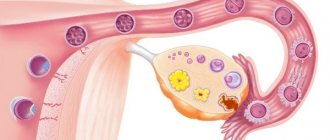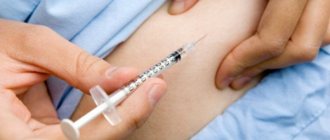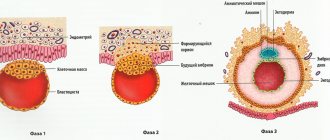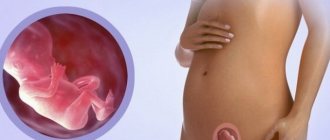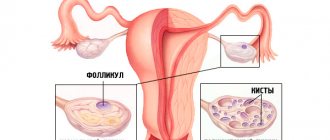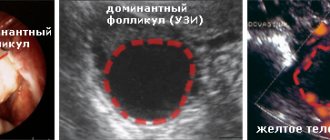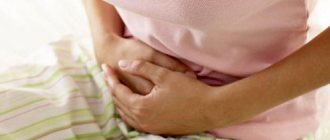Nature has long destined for a woman an important mission - giving birth to a child. Conception is one of the mysterious and most complex processes in the life of the human body. Every woman strives to create a full-fledged family in which the sounds of children's voices will be heard. But, unfortunately, not everyone can experience the joy of parenthood. Currently, the problem of infertile marriages is widespread. The reason for an infertile marriage can be both a woman and a man equally. The process of conceiving a child is quite complex and unpredictable. In the case of infertile couples, one of the reasons may be the problem of egg maturation.
The female body by nature is a mystery. Even during intrauterine development, a girl develops about 4-5 million follicles, the number of which at birth is no more than 1 million. Subsequently, about 300 thousand remain until puberty and the onset of the first menstruation. But, despite the seemingly large number of follicles, only 300-400 of them will have an egg. Unfortunately, not all of these eggs will be fertilized. Large quantity does not mean quality, so not all oocytes will be second-order oocytes ready for conception. It is quite common that the egg does not mature or, on the contrary, is overripe.
How does a woman’s egg mature?
The maturation of a woman's egg occurs in the follicle (Graafian vesicle). From birth, the ovaries of girls contain several million immature germ cells, oocytes. However, by the time of puberty there are about 400 thousand of them. After puberty, one egg leaves the follicle every month in the middle of the menstrual cycle to meet a sperm.
The maturation of the egg itself occurs under the influence of hormones. In the first phase of the menstrual cycle, FSH (follicle-stimulating hormone) provokes active growth of follicles. During this period, about 20 of them mature. However, in the middle of the cycle, only the largest follicle bursts and releases a mature egg. This process is called ovulation.
People's Councils
Why couldn't I get pregnant during ovulation? If conception does not occur, then folk recipes come to the rescue. The herbs used are natural sources of hormones. They have a beneficial effect on a woman’s nervous system, which helps remove the psychological barrier. Sometimes it is he who prevents pregnancy.
Before starting to take the decoction, a woman needs to consult a doctor and take tests to check her hormonal levels. If this is not done, then you can cause the production of hormones that are not necessary in this situation.
Herbs that can be used by women to stimulate ovulation:
- From the fifth day of the menstrual cycle, you need to brew sage. To do this, pour boiling water over 1 teaspoon of herb and leave. Take 1/4 cup of decoction 3 times a day before meals. This dosage schedule should be followed until the 11th day of the cycle. A woman should periodically check the growth and maturation of follicles with an ultrasound.
- Borovaya uterus is taken in the second phase of the cycle. After confirmation of ovulation and to maintain the desired level of progesterone, it must be taken until day 28. The method of use is to brew 1 teaspoon of herb with a glass of boiling water. Take 1/4 cup 3 times a day.
- A herb such as red brush is an effective remedy for normalizing a woman’s hormonal levels. Pour 1 tablespoon of herb into a glass of water and boil for several minutes. Take a tablespoon every 2-3 hours. The course of treatment is 2-3 weeks.
- Plantain seeds can affect a woman's hormonal levels. To do this, brew a spoonful of plant seeds in a cup of water and boil. Take 1 tablespoon 4 times a day for 2 weeks.
All medicinal decoctions must be used only in the correct dosage prescribed by a specialist.
What happens to the egg after ovulation?
At the moment of ovulation, the reproductive cell leaves the follicle and enters the abdominal cavity. However, not all women know where the egg goes after ovulation. Once in the abdominal cavity, it is captured by the fimbriae of one of the fallopian tubes and penetrates the ampullary region. Further along the tube itself, the mature egg rushes to the uterine cavity. Its movement through the fallopian tubes is facilitated by:
- movement of the cilia of the ciliated epithelium in the tubes;
- contraction of the muscle fibers of the organ.
If a woman had sex during the ovulatory period or a few days before it, then there is a possibility that the egg will meet the sperm and fertilization will occur. This happens in most cases directly in the fallopian tubes. If the male and female reproductive cells do not meet, then the egg, reaching the uterine cavity, begins to reverse development and dies.
How long does an egg live after ovulation?
A common question among women planning to conceive concerns how long an egg lives in the body after ovulation. This curiosity is due to the fact that having sexual intercourse during this period increases the chances of pregnancy several times. According to studies by embryologists who studied the development processes of embryos, the female reproductive cell is able to remain viable for 48 hours
from the moment it leaves the follicle.
When talking about how many days an egg lives after ovulation, embryologists call up to 2 days
.
Given this information, every woman planning a pregnancy should make active attempts to conceive directly during this period. For successful fertilization you need:
- Establish the exact time of ovulation in the body (by measuring basal temperature or using special pharmacy tests).
- Do not use any contraception with your partner at this time.
Where does the egg go after ovulation?
Having found out how long an egg lives after ovulation, girls want to know its further path after leaving the follicle. Immediately the germ cell enters the abdominal cavity. Within a few hours after this, it is captured by the fallopian tube. This organ has fimbriae. Their contraction leads to the fact that the mature egg is attracted by the ampullary section of the fallopian tube.
The life of the egg in the body after ovulation depends entirely on whether fertilization occurs or not. If, while moving through the tube, a mature female reproductive cell encounters a sperm and unites with it, a zygote is formed. It gives rise to a new life, starting the process of embryo formation. In the absence of fertilization, upon reaching the uterine cavity, the egg dies.
Timing of egg fertilization after ovulation
Fertilization of an egg after ovulation is possible only during its viability. As noted, it is 48 hours
. If during this time the egg is not fertilized, the reverse process of development begins, which leads to its death. The corpus luteum fades away, the process of endometrial detachment begins, and the cells of this tissue, along with the egg, leave the uterine cavity.
Menstruation begins, which normally lasts 3-5 days for women. During this time, the endometrial layer is restored and a new cycle of egg maturation begins. Knowing how long an egg lives after ovulation has occurred, and on what days of the cycle this process occurs, you can successfully conceive a child.
How does the egg move after ovulation?
Depending on whether the female and male reproductive cells meet during ovulation or not, the process of movement of the egg through the reproductive tract may be different. If at the time of ovulation there are no sperm in the woman’s reproductive system that got there the day before, then the egg unhindered passes through the fallopian tubes, penetrates the uterine cavity and dies. The corpus luteum begins to reverse development, provoking rejection of the uterine endometrium. In this case, it makes no sense to consider the movement of the egg after ovulation day by day.
Approximately 14 days after ovulation, the endometrial cells separate, along with the dead egg, and are released. A woman begins to menstruate. Directly from the first day of menstruation, the countdown of a new cycle and the maturation of a new germ cell begins. This process continues throughout the fertile period, which in women ends by the age of 40-45.
Where does an unfertilized egg go?
According to studies by embryologists, the egg dies after ovulation 24-48 hours
, if it is not fertilized. After the specified time, the reverse process of development begins. The female reproductive cell loses its outer shells, which completely dissolve over time. Its contents remain in the uterine cavity for 11-14 days.
After this period, menstruation occurs. The uterus, by contracting muscle fibers, pushes out the dead egg along with endometrial cells. This way the organ is completely cleansed. Hormones trigger a new process of maturation of the germ cell, and the next cycle begins.
The birth of a girl - the second stage
Mother's sex hormones - estrogens - enter the baby's body at the stage of preparing the body for childbirth. When a newborn girl is separated from her mother’s body, estrogen begins to disintegrate and be removed from the child’s body, and the child’s own sex hormones are not produced. For this reason, many follicles that began to grow stop developing and die (apoptosis).
Burda Media
Egg viability after ovulation in women
The viability of the egg after ovulation is 24-48 hours
. Scientists who have studied female reproductive cells claim that fluctuations in this factor are due to the individual characteristics of the body. Because of this, it is impossible to say exactly how long an egg lives after ovulation in a particular woman. However, there are a number of factors that can influence how long the egg lives after ovulation. Among them:
- A woman’s age
– after 35 years, there is a significant decrease in ovarian reserve, so not even every cycle may be accompanied by ovulation. - Psycho-emotional state
- stress and anxiety are accompanied by the release of adrenaline into the blood, which can suppress the action of sex hormones and shorten the lifespan of the egg.
Why doesn't pregnancy occur again?
Many women who have one baby decide to have a second, but have problems conceiving. Why can’t I get pregnant with my second child during ovulation?
With age, the female body does not get younger, so the reproductive function begins to atrophy. This largely depends on age. If a woman is 30-35 years old, then she should worry about the lack of pregnancy after nine months of unsuccessful attempts. At the age of 35-40 years, you need to seek medical help after six months of failure to conceive.
A favorable time for the birth of a child is considered to be the age of a woman, not older than 30 years. With some effort, even at the age of 35, expectant mothers manage to give birth to an absolutely healthy baby. The main difficulties begin in women closer to 40, when the number of ovulations decreases. This is mainly due to age-related changes in the body, hormonal imbalance, and, as a result, the inability to conceive and give birth to a child.
Despite many factors that prevent pregnancy, a woman over 35 years of age has every chance of successful conception and childbirth.
How do you know if an egg is fertilized after ovulation?
Wanting to quickly find out about successful conception, women often ask doctors whether it is possible to feel the fertilization of the egg after ovulation. Doctors say that the process itself occurs unnoticed by the body. However, just a few days after conception, due to changes in hormonal levels, the woman feels some changes. The following signs of egg fertilization appear after ovulation:
- increased frequency of urination;
- fatigue;
- drowsiness;
- nausea in the morning;
- change in taste preferences;
- enlargement of the mammary glands.
Determining the right day
Reasons that pregnancy did not occur during unprotected sexual intercourse on the day of ovulation (that is, on the day the egg is released from the dominant follicle):
- incorrectly calculated fertile period;
- clinical pathologies;
- external factors.
External factors include stress, exhausting diets, poor sleep and lack of rest and wakefulness. These factors negatively affect the sexual function of both men and women.
Often the reason is precisely the incorrect calculation of the day of ovulation. When the cycle is inconsistent, it is almost impossible to calculate this day with high accuracy.
How to help conception: recommendations for a healthy couple
To get pregnant as soon as possible, you need to lead a healthy lifestyle. The main factors that increase the chances of conceiving a child on the first try:
- correct poses: missionary and its variations, when the man is on top;
- monitoring the ovulation period for several months to calculate the most accurate date;
- giving up bad habits at least six months before conception;
- healthy diet: balanced in proteins, fats and carbohydrates, containing foods with fiber;
- healthy sleep: go to bed and get up at the same time, sleep at least 7 hours a day.
The psychological factor is also important: the mood for conceiving, bearing a child and creating a strong family, eliminating negative emotions, stress, and quarrels. Medications should be avoided if possible.
When is there no cause for concern?
If there is ovulation, but pregnancy does not occur, this is not a reason to immediately suspect infertility in yourself or your partner. Reasons for not getting pregnant the first time:
- unprotected sexual intercourse did not coincide with the woman’s fertile period;
- the attempt occurred during an anovulatory cycle (even a young healthy woman has 1-3 such cycles per year);
- a cold or other condition that reduces immunity in the last month;
- It’s just that this time “the stars didn’t align”: at some difficult stage of conception there was a temporary failure. The sperm failed to penetrate the membrane of the egg, or the fertilized egg did not reach the uterus, or it failed to penetrate the endometrium.
When the body is temporarily weakened by external factors, fertilization can occur, but the cell does not implant. If both partners are healthy, it is worth trying again in the next cycle, when the woman is in the ovulatory phase.
